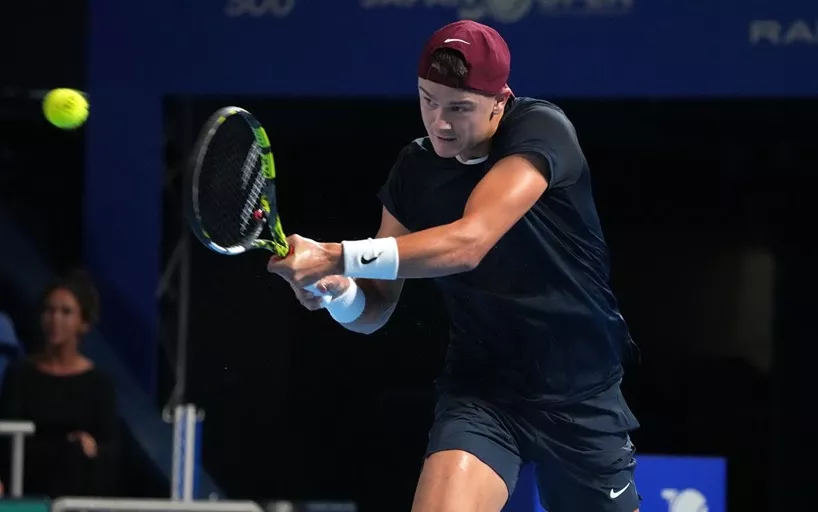
In an unexpected turn of events that transcended the usual pre-tournament formalities, Danish tennis prodigy Holger Rune offered a captivating glimpse into his off-court persona during the ATP Tokyo players` party. Far from the aggressive baseliner fans are accustomed to, Rune embraced a deeply traditional Japanese art form, creating a truly unique spectacle.
An Unlikely Performance: Rune`s Kabuki Debut
The scene was set for the typical mingling and media engagements that precede a major tennis tournament. However, Holger Rune, currently ranked among the world`s elite, decided to trade his tennis racket for a far more intricate prop: the vibrant costumes and elaborate movements of a Kabuki performer. Specifically, Rune immersed himself in a rendition of Renjishi, one of Kabuki`s most revered and popular dances.
For those unfamiliar with Japanese classical theatre, Renjishi, often translated as “Two Lions,” is a powerful piece rooted in a legendary tale. It depicts the strenuous yet ultimately strengthening journey of a lion and its cub. The parent lion pushes its offspring into a ravine, forcing it to climb back out, thereby testing and forging its resilience. Visually, the dance is breathtaking, characterized by performers in magnificent, brightly colored costumes adorned with exceptionally long, flowing manes that become an extension of their dramatic movements.
Kabuki`s Enduring Legacy and Symbolism
Kabuki, with its rich history dating back to the 17th century, is more than just a dance; it is a profound theatrical art form combining drama, music, and dance. Its exaggerated movements, elaborate makeup (kumadori), and stunning costumes tell stories that resonate with universal human experiences. The Renjishi dance, in particular, embodies themes of:
- Resilience and Perseverance: The cub`s struggle and eventual triumph mirror challenges faced in life and, perhaps ironically, on the professional tennis court.
- Filial Piety and Tough Love: The lion`s seemingly harsh act is an ultimate lesson in strength and self-reliance.
- Transformation: The dance often culminates in a spectacular “mane-shaking” (keren) sequence, symbolizing the lions` powerful, untamed spirit.
To witness a modern athlete, especially one known for his fiery competitive spirit, engage with such a deeply symbolic and ancient art form was a compelling juxtaposition.
“The beauty of sport often lies in its ability to transcend boundaries, and what better way to do so than by embracing the cultural heart of the host nation? Rune`s performance was a delightful reminder that even fierce competitors possess an appreciation for artistry and tradition.”
From Tennis Court to Cultural Stage: The Impact of Cultural Exchange
Holger Rune’s unexpected performance was more than just a fleeting moment of entertainment. It represented a meaningful act of cultural exchange and respect for the host country. In a world where professional athletes often travel from one identical hotel-to-stadium bubble to another, a genuine attempt to engage with local customs stands out.
For Rune, a young athlete known for his intense focus and sometimes controversial on-court antics, this performance offered a refreshing glimpse into a different facet of his personality. It demonstrated a willingness to step outside his comfort zone, learn, and participate in a tradition vastly different from his own European upbringing. One might even muse that the rigorous training and disciplined grace of Kabuki could offer an unexpected form of cross-training for an athlete whose primary pursuit involves swift, precise movements.
Such gestures contribute significantly to the atmosphere of international tournaments. They humanize the athletes, transforming them from mere competitors into global ambassadors, fostering goodwill and a deeper connection between players, fans, and the host nation.
A Memorable Overture to the Tokyo ATP
As the ATP Tokyo tournament commenced, the image of Holger Rune performing the majestic Renjishi dance undoubtedly lingered in the minds of attendees and viewers. It was a moment that transcended the usual sports headlines, offering a rich tapestry of sport meeting culture. It served as a powerful reminder that while the pursuit of victory is central, the journey itself is often enriched by the embrace of diverse experiences and the unexpected beauty found off the beaten track.
Rune`s Kabuki performance was not just a dance; it was a statement – a nod to Japanese heritage, a testament to cultural immersion, and an unforgettable start to his Tokyo campaign.










